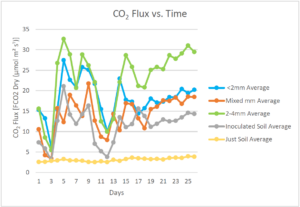Project Overview
Commodities
Practices
Proposal abstract:
The Nexus Project is a collaborative research and outreach effort
addressing regional agricultural challenges and aims to enhance
the resilience of local farms by evaluating sustainable
technology solutions. We propose two activities to achieve our
goals with support from the S-SARE On-Farm Research Grant
program.
(1) Efficient Greenhouse Heating: evaluation of the
upgraded RZH
We propose separating the heat storage from the backup heat
source by installing an on-demand water heater. This method will
ensure that our system meets the needs of each cooperative farm,
such as renewable energy collection efficiency and consistent
soil temperature. By doing so, the heat storage temperature
decreases after using the heat to warm the soil overnight. It
allows cooler fluid to enter the solar collector, increasing
efficiency. In the Nexus system, when the temperature of the RZH
fluid is around 100 °F, the soil is maintained at an appropriate
temperature, about 75 °F for germination soil. The proposed
system design increases overall efficiency by maintaining the
appropriate temperature of the soil with a small amount of energy
because the on-demand water heater heats the fluid only when the
temperature of the fluid leaving the heat storage is lower than
the set temperature.
With the support of the NC BRI grant, an on-demand water heater
was added to the existing RZH of Springhouse Farm in December
2022. Unlike storage tank water heaters that produce and store
large amounts of hot water, on-demand water heaters increase
energy efficiency by producing only as much hot water as needed
when it is needed. During the trial operation conducted for about
a month in the spring of 2023, the new system maintained stable
growing conditions.
 Fig 4. On-demand water heater for RZH
Fig 4. On-demand water heater for RZHat Springhouse Farm[/caption]
Through this grant cycle of S-SARE On-Farm research, we propose a
study to collect and analyze data to evaluate the energy
efficiency and growing conditions of the upgraded RZH system. We
will collect data for the on-demand water heater RZH without
solar energy collection in the first year and with solar energy
collection in the second year. By comparing the two data sets, we
will be able to know the improved solar energy collection by
separating the heat storage and the backup heat source.
Additionally, by evaluating RZH which operates solely with an
on-demand water heater, it will be possible to propose a design
that reduces the initial cost burden on local farms.
(2) Biochar soil application experiments and field
trials
Biochar application to soil has been proven as a viable means of
increasing soil fertility and carbon sequestration [13]. The
carbon-enriched structure of biochar gives a great option for
long-term Carbon sequestration. About 50% of the Carbon contained
in the biomass remains in biochar with a very stable structure
after conversion. Therefore, Carbon sequestration with biochar
application to soil is notable compared to burning (3%) and
biological decomposition (10 to 20% after 5 to 10 years) [13].
Significant porosity and high surface area of biochar provide
different habitat properties appropriate for various soil
microbes and enhance moisture and nutrient retention resulting in
microbial population growth [14]. Inoculated biochar with organic
fertilizers such as compost and digestate from anaerobic
digestion is an effective method for biochar application to soil.
Over the past few years, the Nexus Project has been actively
conducting research on biochar produced from local hardwood with
support from NC BRI grant programs. CO2 flux data using a soil
gas flux analyzer confirmed an increase in microbial activity in
soil mixed with inoculated biochar compared to samples without
biochar. A plant growth study performed on a 125 ft. by 4 ft.
strip of degraded soil, once used to grow tobacco, at one of our
cooperative farms, Against the Grain Farm exhibited the
differences in immediate effect by the various inoculated and
not-inoculated biochar applications. In terms of dry root and
shoot masses and lengths and root-to-shoot ratios, the soil
applied with 2mm biochar inoculated with compost tea showed a
two-fold improvement compared to the soil without application. We
also looked at different ways to produce biochar with hardwood
available in the region, grind, and effectively inoculate biochar
at a relatively low cost.
 Fig 5. CO2 flux of soil with/without
Fig 5. CO2 flux of soil with/withoutinoculated biochar treatment[/caption]
We propose to conduct small-scale experiments and field trials
using biochar produced from local oak trees, and Hybrid poplar,
Miscanthus giganteus, and Arundo donax grown in the Nexus
Bioenergy crop field. Using the soil from Springhouse Farm, we
will conduct experiments in our greenhouse laboratory and field
application research and evaluate its effects on crop and soil
health. We will produce, crush, and inoculate biochar in the most
efficient and reliable ways revealed through our previous
studies. Eventually, we aim to provide a comprehensive guideline
for soil management practices utilizing biochar. This resource is
essential to achieve positive and consistent effects on our
cooperative farms and for further dissemination to farms in the
Southern Appalachian region.
With support from S-SARE’s On-Farm Research grant, we will be
able to continue demonstrating the performance of the heating
system and develop a practical guide to biochar application, thus
enhancing this closed-loop system. We envision that this research
provides more appropriate technologies and farming practices that
farmers in Southern Appalachia can adopt for sustainable farming.
Project objectives from proposal:
(1) Efficient Greenhouse Heating: evaluation of the upgraded RZH
The performance of RZH running on a newly installed on-demand water heater will be assessed by four measurable factors: solar energy gain, energy saving, nighttime soil temperature distribution, and break-even point.
Solar Energy Gain: The overall heat gain from the Nexus system’s solar thermal collector will be calculated in BTUs. Since all the solar thermal energy gained from the solar collector is stored in the heat storage, the difference between the minimum and the maximum temperatures of the heat storage each day is the temperature rise by solar radiation. Therefore, the thermal energy gained from the system can be calculated by multiplying the total degrees of temperature rise of the heat storage, mass, and specific heat of 50% propylene glycol-water solution.
Energy Saving: The effectiveness of the system can be proven by comparing propane usage before and after the installation. However, rather than simply comparing propane usage for each year, the heating amount should be compared according to the temperature of each year. To do so, we will calculate the heating degree days (HDDs) during the period when heating is used, and then divide the propane usage by that value to get each year’s weather-adjusted fuel consumption (propane usage/HDDs). The HDD of a day was obtained by subtracting the average temperature of the day from the base temperature (55°F: the setting point when using forced-air heating in previous years), and all the HDDs of the heating period were summed to estimate the seasonal heating needs. The weather-adjusted fuel consumption of 2025 and 2026 will be compared to those of the previous years.
Soil Temperature Distribution: For the system to be effective and efficient, it must maintain productive conditions while saving energy. To evaluate this, soil temperature data, which is the most important factor for the stable development of crops during the cold season, will be collected and analyzed. For analysis under various conditions, we will examine (1) the daily RZH soil temperature distribution in March of each year and (2) the temperature difference between inside the greenhouse and the soil on the RZH bench on nights when the temperature outside was below freezing. The temperatures of soil, inside and outside the greenhouse will be logged and collected every minute, and the data will be analyzed using Microsoft Excel.
Break-even point: To evaluate the economics of the proposed system, a comparison will be made with the propane forced-air unit heater, which was Springhouse Farm's initial heating system. We will determine the break-even point based on the initial installation cost of the proposed system and the propane cost savings compared to the propane costs of 2016 and 2017 when a propane forced-air unit heater was used.
(2) Biochar soil application experiments and field trials
We will first conduct analytical and small-scale experimental research in the laboratory to determine the optimal mixing ratio of biochar-organic matter for co-composting. Based on the determined mixing ratio, it will be applied to our cooperative farm, and field data will be collected and evaluated. Finally, a manual will be created that explains in detail how to produce, crush, co-compost, and apply biochar to the field.
Biochar inoculation by co-composting and nutrients and microbial activity analysis: Four types of biomass, Hybrid poplar, Miscanthus giganteus, Arundo donax, and local oak trees will be used to produce biochar for this study. Co-composting will be done in two ways: aerated static compost (slow composting) and compost-tea (fast composting). Organic matters (agricultural waste) will be achieved from the cooperative farm. The mixing ratios of 0-50 weight % will be applied to each co-composting method to analyze nutrient composition and microbial activity. The samples will be sent to the analysis lab at NCDA & CS for nutrient analysis. The microbial activity of each sample will be measured by CO2 flux over time using a soil gas flux analyzer.
Soil fertility analysis (pre- and post-planting) and plant growth experiments: Based on the results of the nutrients and microbial activity analysis, we will determine the optimal mixing ratio(s) for each inoculation method (slow and fast) and design the growing experiments. Each inoculated biochar will be applied to soil from the cooperative farm at an application ratio of 0, 2.5, 5, and 10% by mass. These ratios are set up based on the literature review [15&16] and our previous study that converted metric tons per hectare into mass ratios based on the soil density in the region [17]. The control and treated soil samples will be analyzed using soil test kits. Lettuce and tomato seedlings will be prepared by germinating under the same conditions. The plant growth experiment will be performed in our laboratory greenhouse and replicated three times for reliable results. Aboveground and underground biomass weights will be measured as an indicator of productivity. The plant samples and post-harvest soil samples will be analyzed using plant tissue nutrients test kits and soil test kits.
Field trials: We will work with our farmer cooperator to design field trials. The optimal mixing ratio and application rate will be determined based on the growing experiments and analysis. Compost and inoculated biochar samples will be analyzed before field application. Control and treated soil samples will be analyzed both pre- and post-harvest. Plant growth analysis will be performed in the same method as the plant growth experiments.
Biochar soil application manual: We will create a manual that is practical and relevant to the region, based on previous research and proposed projects. Mixing ratios for composting and soil application based on weight in the study will be converted to volume to make the process easier for users to follow. Various and efficient biochar production and grinding methods will be introduced. With our current biochar kiln loan program, accumulated knowledge and resources, and comprehensive manuals, we help local farmers easily apply biochar in the field.